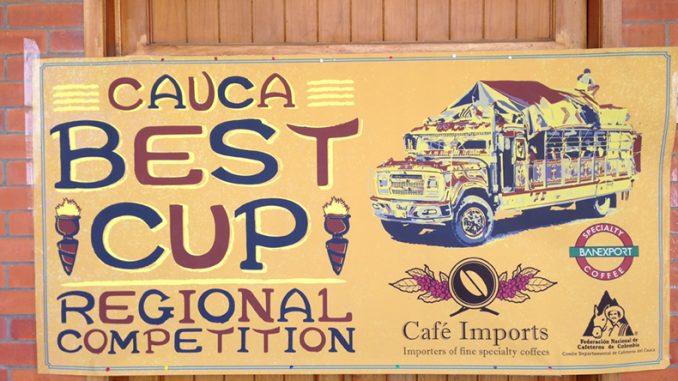
Now in its second year the Cauca Best Cup competition brings a new interest to the diverse coffees found in the southwestern Colombian department
BY ASHLEY RODRIGUEZ
SPECIAL TO BARISTA MAGAZINE
SPECIAL TO BARISTA MAGAZINE
Once upon a time, simply labeling the country of origin on a bag of coffee was enough information. It was either an Ethiopian, Gutatemalan, or Colombian coffee, and that was enough to make a judgement about the coffee inside. Or so it seemed. Then, we started going a little deeper. Not just the country of origin, but regions within each country started showing up on the labels. The coffee was more specifically from Yirgacheffe or Huehuetenango or Huila. And those individual regions started to get their own profiles, reputations, and stereotypes. But what if those stereotypes were wrong? What if they were too general for the real diversity of coffee produced in each region? How could an undervalued producing area highlight its exceptional coffees?
It was this conundrum that Café Imports and their partner in Colombia, Banexports, were struggling with when trying to find ways to support the coffee farmers (and their terrific coffees) of what traditionally has been an under appreciated area of Colombia, Cauca.( The video above explains some of their thinking on the subject, their strategy to overcome it – namely the Cauca Best Cup competition, and is just generally beautiful.)

While there are a number of, rightfully so, famous coffee regions in Colombia, there are a number of growing regions that are often overlooked or overshadowed by more prestigious or recognizable names. And that’s what the Cauca Best Cup competition hopes to highlight ”a coffee region that, although well-known, has been overshadowed by its more famous next-door neighbors. Now in its second year, the competition was started by Café Imports in order to bring attention to the small but highly productive and growing region in the southwestern part of Colombia.

Located in between the more ˜illustrious’ regions of Nariño and Huila, Cauca produces coffees that are œbig, rich, juicy with acidity that is a little bit racy, or that’s how Andy Reiland, Café Import’s Media Pro, would describe coffees from the region. However, these tasting notes are not a hard and fast rule, and this competition has helped shine a light on just how dynamic coffees from this region can be. œThe contributors are all producers within a single state, growing in the same climate, with similar terroir, processing methods, and varieties. Yet even within this degree of limited variation, we’re encountering a vast range of characteristics, shares Gabe Dunn, head of Café Imports Europe, who was in attendance at the second annual Cauca Best Cup held earlier this fall. œFrom delicate florals reminiscent of jasmine tea, to heavy, syrupy viscosity, Cauca has something for the whole family.
The Cauca Best Cup competition is in its second year ( œofficially making it an annual event, Gabe states), and farmer participation has already increased from 200 entrants to over 500 this year. This is partially due to the fact that the competition hopes to provide monetary rewards for farmers who are paying attention to quality on their farms. œWhile the standard microlot in Colombia fetches somewhere around 3.00 USD/lb. for the producer, the top coffee in this competition [in 2015] went for $31.50 USD! Second and third went for $20.40 USD and $16 respectively, says Gabe. Prices are determined through auction, and bidders are given information about how the coffees perform after days of rigorous cupping and scoring.

Does this sound like the Cup of Excellence, a competition started in 1999 by the infamous George Howell during his absence from the commercial coffee game? While the competition follows a ˜loose COE’ format, one major difference is the live auction at the end of the cupping and evaluative stage. Once coffees are cupped, scored, and whittled down to the top 12, roasters and green buyers sit alongside farmers as they bid for high-scoring lots. The air is lively and exciting, and farmers are often egging on buyers to bid more (“Subtle!” they’ll shout, which roughly translates to “Turn it up!”). Buyers can then interact with the people who grew the coffee they just bought instantaneously, with many buyers meeting farmers for the first time through this competition.

Coffee competitions like this are incredibly illuminative, because they both tie producers to roasters and help us expand our collective coffee knowledge and understand how coffees from a very specific region taste and differ from other coffees in the region. Traceability becomes possible during multiple steps of production, and that’s why Café Imports hopes this competition model is not just limited to Cauca. Look for Café Imports to launch another regionally-based coffee competition in the next few months, and if you want more information about this competition or where you can buy winning coffees, visit the blog on the Café Imports website.
 ABOUT THE AUTHOR
ABOUT THE AUTHOR
Ashley Rodriguez thought that she’d take a break from teaching middle school science and putz around in a coffee shop for a few months. She ended up digging it way more than teaching (and was vaguely better at it). After spending 5 years making coffee in New York, she now works for Sightglass Coffee in San Francisco. Follow her on Twitter at @ashcommonname.

